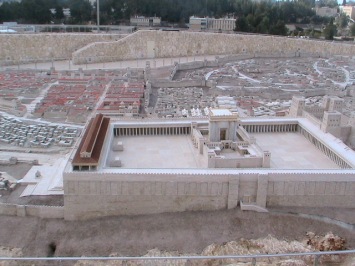
Model of the Second Temple at the Israel Museum
The Need for Proof of the Jewish Temples
The United Nations Educational Scientific and Cultural Organization (UNESCO) adopted today a biased and political resolution that disregards Judaism’s historic connection to the Temple Mount, casts doubts regarding the Jewish connection to the Western Wall, and protests against the Israel Antiquities Authority’s attempts to supervise construction work on and around the Temple Mount in order to preserve the antiquities and other archaeological data.
This is a purely political resolution that was composed by Palestinian officials and that was accepted by UNESCO as is. It seeks only to preserve the heritage of Islam, and while this is important, UNESCO must not do this at the expense of Jewish and Christian heritage and culture. This resolution does not recognize the daily reality of Jerusalem or the Temple Mount, and its political agenda is in opposition to UNESCO’s own charter and purpose of protecting and promoting science, culture, education and heritage.
The existence of the Jewish Temples are beyond any doubt. There is substantial evidence in the numerous historical sources that witnessed them, including Pagan historians that were not affected by the Jewish or Christian tradition, such as Berossus (3rd Century BCE), Menander of Ephesus (2nd Century BCE), Hecataeus of Abdera (c. 300 BCE), Mmaseas of Patara (c. 200 BCE), Diodorus of Sicily (1st century BCE), Strabo (1st century BCE), Tacitus (1st Century CE) and many others.
Although it is not possible in today’s political climate to conduct a proper archaeological excavation on the Temple Mount, there are many archaeological finds that support the almost universally accepted fact: it is the site of the Jewish Temples. Many of the artifacts come from the Temple Mount Sifting Project, and many others can either still be observed at the Temple Mount, were found accidentally during renovations, or were found in archaeological excavations at surrounding sites.
Following is a list of some selected artifacts from among many others:
 Temple Warning Inscription – In 1871, French archaeologist Clermont-Ganneau found a Greek inscription warning gentiles not to enter further into the temple compound. These kind of inscriptions were also witnessed by the 1st century CE historian, Josephus Flavius (War 5, v, 2; War 6, ii, 4; Antiquities 15, xi, 5).
Temple Warning Inscription – In 1871, French archaeologist Clermont-Ganneau found a Greek inscription warning gentiles not to enter further into the temple compound. These kind of inscriptions were also witnessed by the 1st century CE historian, Josephus Flavius (War 5, v, 2; War 6, ii, 4; Antiquities 15, xi, 5).
 The Beit Hatekia Inscription – Archaeologist Prof. Benjamin Mazar in 1972 found this Hebrew inscription which had fallen from the south-western corner of the Temple Mount and was found in the rubble being excavated by archaeologists excavating nearby. The stone carries the inscription “lebeit hatekia lehakhriz” which means “to the house of the blowing of the trumpet to announce.” Jewish historians and rabbinical sources described the custom of blowing the trumpets from the Temple Mount in order to announce the time of the sabbath and sacred holy days (Sukka 5: 5; Babylonian Talmud Shabat 35: 2; Tosefta Sukka 4; Wars IV, X, 12).
The Beit Hatekia Inscription – Archaeologist Prof. Benjamin Mazar in 1972 found this Hebrew inscription which had fallen from the south-western corner of the Temple Mount and was found in the rubble being excavated by archaeologists excavating nearby. The stone carries the inscription “lebeit hatekia lehakhriz” which means “to the house of the blowing of the trumpet to announce.” Jewish historians and rabbinical sources described the custom of blowing the trumpets from the Temple Mount in order to announce the time of the sabbath and sacred holy days (Sukka 5: 5; Babylonian Talmud Shabat 35: 2; Tosefta Sukka 4; Wars IV, X, 12).
 DKA LYH seal – In 2011, Archaeologist Eli Shukrun found a tiny fired clay object stamped with an inscription consisting of the Hebrew letters דכא ליה (“DKA LYH” or ”Deka Leyah”) in a drainage tunnel at the foot of the southern end of the Western Wall. Talmudic scholar, Prof. Shlomo Naeh, convincingly showed that this is a unique object that was used as a token / voucher that enabled the Temple administrator priests to keep track of commerce related to sacrificial offerings. This practice is documented in the Mishna, the first written redaction of Jewish Oral Law dating to around 200 CE (Shekalim 5: 3-5). The inscription upon the seal marks the type of sacrifice: “Dekhar” (ram), “Aleph” (first day of the week) and “Yehoyariv” (one of the twenty-four priestly families who worked shifts in the Temple).
DKA LYH seal – In 2011, Archaeologist Eli Shukrun found a tiny fired clay object stamped with an inscription consisting of the Hebrew letters דכא ליה (“DKA LYH” or ”Deka Leyah”) in a drainage tunnel at the foot of the southern end of the Western Wall. Talmudic scholar, Prof. Shlomo Naeh, convincingly showed that this is a unique object that was used as a token / voucher that enabled the Temple administrator priests to keep track of commerce related to sacrificial offerings. This practice is documented in the Mishna, the first written redaction of Jewish Oral Law dating to around 200 CE (Shekalim 5: 3-5). The inscription upon the seal marks the type of sacrifice: “Dekhar” (ram), “Aleph” (first day of the week) and “Yehoyariv” (one of the twenty-four priestly families who worked shifts in the Temple).
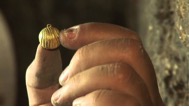 High Priest Golden Bell – In the same excavation at the drainage tunnel by Eli Shukrun, a golden bell was found dating to the Second Temple period. There is no precedent for this artifact from any excavation in Israel. Our only knowledge of such an object is from the biblical description of the bells sewn to the garment worn by the high priest (Ex. 28:33-34).
High Priest Golden Bell – In the same excavation at the drainage tunnel by Eli Shukrun, a golden bell was found dating to the Second Temple period. There is no precedent for this artifact from any excavation in Israel. Our only knowledge of such an object is from the biblical description of the bells sewn to the garment worn by the high priest (Ex. 28:33-34).
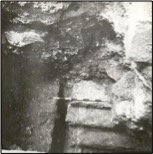 Miqvaot – Numerous Miqvaot (Jewish ritual immersing purification baths) were found in the areas surrounding the Temple Mount. There are also documented underground cavities upon the Temple Mount that were surveyed by explorers in the 19th century. One less known cistern which is located directly under the Al-Aqsa mosque was found by the British Mandate Antiquities Department in the 1940’s, but was never published. We found the documentation of this Miqveh in the British Antiquities Department archives and published it in 2008.
Miqvaot – Numerous Miqvaot (Jewish ritual immersing purification baths) were found in the areas surrounding the Temple Mount. There are also documented underground cavities upon the Temple Mount that were surveyed by explorers in the 19th century. One less known cistern which is located directly under the Al-Aqsa mosque was found by the British Mandate Antiquities Department in the 1940’s, but was never published. We found the documentation of this Miqveh in the British Antiquities Department archives and published it in 2008.
 Herodian Architecture – Several locations upon the Temple Mount, especially the Double Gate entry halls under the Al-Aqsa mosque, preserve until today one of the finest examples of Herodian art engraved on stone. Several gates of today’s Temple Mount still preserve remnants of gates from the Late Second Temple Period.
Herodian Architecture – Several locations upon the Temple Mount, especially the Double Gate entry halls under the Al-Aqsa mosque, preserve until today one of the finest examples of Herodian art engraved on stone. Several gates of today’s Temple Mount still preserve remnants of gates from the Late Second Temple Period.
 Eastern Wall’s section from the First Temple Period – The lower courses north and south of the Golden Gate in the eastern wall are dated by Temple Mount scholars to the First Temple Period (see Leen Riymeyer, The Quest 2006). The drafting of these stones resembles masonry stones from walls in other sites dated to the First Temple period.
Eastern Wall’s section from the First Temple Period – The lower courses north and south of the Golden Gate in the eastern wall are dated by Temple Mount scholars to the First Temple Period (see Leen Riymeyer, The Quest 2006). The drafting of these stones resembles masonry stones from walls in other sites dated to the First Temple period.
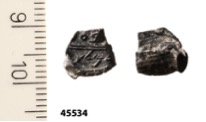 First Temple Period refuse pit at the eastern slopes of the Temple Mount – In 2009, we uncovered an ancient refuse pit on the slopes of the Temple Mount, which yielded rich archaeological material dating from the 10th century BCE (the time of King Solomon) to the 7th century BCE. The finds included a unique seal impression with an inscription that describes a tax that were given to the King from the city of Gibeo’n. According to the biblical descriptions, the house of the king was also situated on the Temple Mount.
First Temple Period refuse pit at the eastern slopes of the Temple Mount – In 2009, we uncovered an ancient refuse pit on the slopes of the Temple Mount, which yielded rich archaeological material dating from the 10th century BCE (the time of King Solomon) to the 7th century BCE. The finds included a unique seal impression with an inscription that describes a tax that were given to the King from the city of Gibeo’n. According to the biblical descriptions, the house of the king was also situated on the Temple Mount.
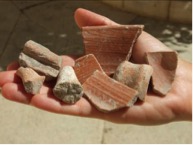 First Temple Period assemblage found in Waqf electrical wire trench – During the Waqf’s excavation of a trench in 2007 supervised by the Israel Antiquities Authority, a rich First Temple period assemblage was found just southeast of the raised platform of the Temple Mount. It included pottery, bones and fragments of figurines dating to the 6th century BCE, the later days of the First Temple period.
First Temple Period assemblage found in Waqf electrical wire trench – During the Waqf’s excavation of a trench in 2007 supervised by the Israel Antiquities Authority, a rich First Temple period assemblage was found just southeast of the raised platform of the Temple Mount. It included pottery, bones and fragments of figurines dating to the 6th century BCE, the later days of the First Temple period.
 A Water cistern at the southeast corner of the Raised Platform – A large underground water cistern documented by the researchers of the 19th century was recently dated by archaeologist Tzvika Tzuk to the First Temple period according to similarly shaped water cisterns recovered in other sites.
A Water cistern at the southeast corner of the Raised Platform – A large underground water cistern documented by the researchers of the 19th century was recently dated by archaeologist Tzvika Tzuk to the First Temple period according to similarly shaped water cisterns recovered in other sites.
Artifacts from the Soil Discarded from the Temple Mount
The following were all found by the Temple Mount Sifting Project.
 Imer Seal Impression – The most direct evidence ever found of the First Temple comes from a tiny seal impression made of clay that was originally attached to a fabric sack, possibly containing silver or gold. The seal bears the inscription: “(Belonging to) […]lyahu (son of) Immer”. The Immer family was a well-known priestly family at the end of the First Temple period, around the 7th – 6th Centuries BCE. Pashhur son of Imer is mentioned in the Bible as “Chief officer in the house of God” (Jer. 20:1). It may be assumed that this object sealed some precious goods that were kept in the Temple treasury which was managed by the priests. This sealing is the first ever evidence of ancient Hebrew writing from the Temple Mount and of the administrative activity which took place in the First Temple.
Imer Seal Impression – The most direct evidence ever found of the First Temple comes from a tiny seal impression made of clay that was originally attached to a fabric sack, possibly containing silver or gold. The seal bears the inscription: “(Belonging to) […]lyahu (son of) Immer”. The Immer family was a well-known priestly family at the end of the First Temple period, around the 7th – 6th Centuries BCE. Pashhur son of Imer is mentioned in the Bible as “Chief officer in the house of God” (Jer. 20:1). It may be assumed that this object sealed some precious goods that were kept in the Temple treasury which was managed by the priests. This sealing is the first ever evidence of ancient Hebrew writing from the Temple Mount and of the administrative activity which took place in the First Temple.
Artifacts from the time of King Solomon – Some of the artifacts found by the Sifting Project date to the 10th-9th centuries BCE, the time of King Solomon, builder of the First Temple, and his successors. These artifacts are rare in Jerusalem and they have brought forth critical evidence in the heated debate about the size of Jerusalem in this period. Some scholars in the past doubted that the Temple Mount was annexed to Jerusalem during the 10th century BCE. They suggest that Jerusalem was not a capital city but rather a small village. These artifacts contradict this minimalist assertion and confirm the biblical account regarding Jerusalem during this period. The finds include pottery sherds, a rare stone seal that is conical in shape, and a rare arrowhead.
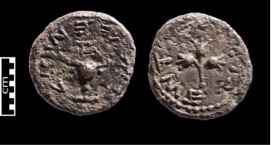 Half-Shekel Silver Coin – From the Second Temple period the Sifting Project has recovered over 800 Jewish coins. Many of the coins from the late Second Temple period seem to be burnt, probably as a result of the fire that led to the destruction of the Temple. A particularly exciting find is a rare silver coin minted during the first year of the Great Jewish Revolt against Rome (66/67 C.E.). The coin features a branch with three pomegranates and an inscription in ancient Hebrew script reading “holy Jerusalem” (ירושלמ קדשה). The reverse side of the coin features temple vessels and is inscribed “half shekel” (חצי השקל).
Half-Shekel Silver Coin – From the Second Temple period the Sifting Project has recovered over 800 Jewish coins. Many of the coins from the late Second Temple period seem to be burnt, probably as a result of the fire that led to the destruction of the Temple. A particularly exciting find is a rare silver coin minted during the first year of the Great Jewish Revolt against Rome (66/67 C.E.). The coin features a branch with three pomegranates and an inscription in ancient Hebrew script reading “holy Jerusalem” (ירושלמ קדשה). The reverse side of the coin features temple vessels and is inscribed “half shekel” (חצי השקל).
These half-shekel coins were used to pay the Temple tax during the Great Revolt, replacing the Tyrian shekel used previously. It appears that these half-shekel coins were minted by the Temple authorities on the Temple Mount itself. This half-shekel tax for the sanctuary, mentioned in the Book of Exodus (30:13–15), required every male to pay half a shekel to the Holy Temple once a year. Our half-shekel coin is well preserved but bears scars of the conflagration that destroyed the Second Temple in 70 C.E.
 Herodian Temple Courts Lavish Paving – Hundreds of opus sectile stone tiles were found in the sifting. Opus sectile (Latin: “cut work”) is a technique of paving floors in lavish geometric patterns using meticulously cut and polished polychrome tiles. Many of the tiles have been dated to the Late Second Temple period based on parallels found in Herodian palaces. Their dimensions are based on fractions of the Roman foot (c. 29.6 cm). Flavius Josephus, writing about the open courts surrounding the Temple, says, “Those entire courts that were exposed to the sky were laid with stones of all sorts” (Jewish War 5:2) Lately we have managed to reconstruct some of the patterns of these special floors using geometrical principles and through similarities found in floor designs used by Herod at other sites.
Herodian Temple Courts Lavish Paving – Hundreds of opus sectile stone tiles were found in the sifting. Opus sectile (Latin: “cut work”) is a technique of paving floors in lavish geometric patterns using meticulously cut and polished polychrome tiles. Many of the tiles have been dated to the Late Second Temple period based on parallels found in Herodian palaces. Their dimensions are based on fractions of the Roman foot (c. 29.6 cm). Flavius Josephus, writing about the open courts surrounding the Temple, says, “Those entire courts that were exposed to the sky were laid with stones of all sorts” (Jewish War 5:2) Lately we have managed to reconstruct some of the patterns of these special floors using geometrical principles and through similarities found in floor designs used by Herod at other sites.
Jewish Linkage to the Temple Mount after the Temple Destruction
The Jewish rabbinical sources during all centuries after the Second Temple’s destruction in year 70 CE indicate that the site was the focus of Jewish prayers and thoughts. In addition, several Jewish graffiti inscriptions were found within the Temple Mount done by Jewish pilgrims during the medieval periods. This is in spite of the difficulties and bans put upon Jews dwelling and visiting in Jerusalem. These inscriptions indicate a continuous linkage of the Jewish people to their holiest site.
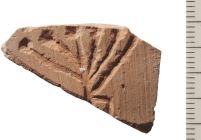
A potsherd bearing a symbol resembling the Temple’s menorah was found in the sifting. Based on its clay type and texture, the potsherd dates to the period of Byzantine rule over Jerusalem , from 324 to 640 CE or the beginning of Early Islamic Period (7th-8th Century CE) showing that even then, there was a connection to the Jewish Temple that had been destroyed.
Documents that were found in the Cairo Geniza tell us about the Jewish residents of Jerusalem during the Early Islamic period who had a custom to encircle the Temple Mount and pray in front of the Temple Mount gate. One of the most prominent Jewish rabbis in the Medieval Era, the Rambam, wrote that he entered the Temple Mount and set upon himself a private annual feast day for that occasion.
Summary
As mentioned above, due to the comprehensive historical sources and Jewish, Christian and Muslim traditions about the Temple Mount, there is no need for archaeological evidence to prove the existence of the Jewish Temple upon the Temple Mount. Unfortunately, the Temple Denial agenda that was created 20 years ago and promoted by Palestinian politicians and religious leaders managed to expand to some Arab scholars and apparently has also now been adopted by UNESCO. Since they claim that no archaeological artifact proving the existence of the Jewish Temples upon the Temple Mount was ever found, it is important to bring this proof and research regarding these very real artifacts to the general publish.








































